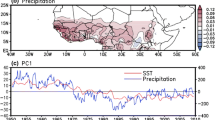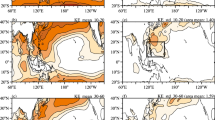Abstract
The Yangtze River valley (YRV), located in central-eastern China, has witnessed increased numbers of heat waves in the summer since 1951. Knowing what factors control and affect the interannual variability of heat waves, especially distinguishing the contributions of anomalous sea surface temperature (SST) forcings and those of internal modes of variability, is important to improving heat wave prediction. After evaluating 70 members of the atmospheric model intercomparison project (AMIP) experiments from the 25 models that participated in the coupled model intercomparison project phase 5 (CMIP5), 13 high-skill members (HSMs) are selected to estimate the SST-forced variability. The results show that approximately 2/3 of the total variability of the July–August heat waves in the YRV during 1979–2008 can be attributed to anomalous SST forcings, whereas the other 1/3 are due to internal variability. Within the SST-forced component, one-half of the influence is from the impact of the El Niño–Southern Oscillation (ENSO) and the other half is from non-ENSO related SST forcings, specifically, the SST anomalies in the North Pacific and the North Atlantic. Both the decaying El Niño and developing La Niña accompanied by a warm Indian Ocean and cold central Pacific, respectively, are favorable to hotter summers in the YRV because these patterns strengthen and extend the western North Pacific Subtropical High (WNPSH) westwards, for which the decaying ENSO plays a dominant role. The internal variability shows a circumglobal teleconnection in which Rossby waves propagate southeastwards over the Eurasian Continent and strengthen the WNPSH. Atmospheric model sensitivity experiments confirm that non-ENSO SST forcings can modulate the WNPSH and heat wave variability by projecting their influences onto the internal mode.














Similar content being viewed by others
References
Adler RF et al (2003) The Version 2 Global precipitation climatology project (GPCP) monthly precipitation analysis (1979–present). J Hydrometeorol 4:1147–1167
Ashok K, Saji NH (2007) On the impacts of ENSO and Indian Ocean dipole events on sub-regional Indian summer monsoon rainfall. Nat Hazards 42:273–285
Chen R, Lu R (2015) Comparisons of the circulation anomalies associated with extreme heat in different regions of eastern China. J Clim 28:5830–5844
Chen X, Zhou T (2014) Relative role of tropical SST forcing in the 1990s periodicity change of the Pacific-Japan pattern interannual variability. J Geophys Res 119:13,043–13,066. doi:10.1002/2014JD022064
Dee DP et al (2011) The ERA-Interim reanalysis: configuration and performance of the data assimilation system. Q J R Meteorol Soc 137:553–597. doi:10.1002/qj.828
Deser C, Tomas RA, Peng S (2007) The transient atmospheric circulation response to North Atlantic SST and sea ice anomalies. J Clim 20:4751–4767
Ding Q, Wang B (2005) Circumglobal teleconnection in the Northern Hemisphere summer. J Clim 18:3483–3505
Ding T, Qian W, Yan Z (2010) Changes in hot days and heat waves in China during 1961–2007. Int J Climatol 30:1452–1462. doi: 10.1002/joc.1989
Du Y, Xie SP, Huang G, Hu K (2009) Role of air-sea interaction in the long persistence of El Niño-induced north Indian Ocean warming. J Clim 22:2023–2038
Gong DY, Pan YZ, Wang JA (2004) Changes in extreme daily mean temperatures in summer in eastern China during 1955–2000. Theor Appl Climatol 77:25–37
Hartmann DL et al (2013) Observations: atmosphere and surface. In: Stocker TF et al (eds) Climate change 2013: the physical science basis. Contribution of working group I to the fifth assessment report of the intergovernmental panel on climate change. Cambridge University Press, Cambridge
He C, Zhou T, Wu B (2015) The key oceanic regions responsible for the interannual variability of the western North Pacific subtropical high and associated mechanisms. J Meteor Res 29:562–575
Hu KM, Huang G, Qu X, Huang RH (2012) The impact of Indian Ocean variabilityon high temperature extremes across the southern Yangtze River valley in late summer. Adv Atmos Sci 29(1):91–100. doi:10.1007/s00376-011-0209-2
Hu K, Huang G, Wu R (2013) A strengthened influence of ENSO on August high temperature extremes over the southern Yangtze River Valley since the late 1980s. J Clim 26:2205–2221
Kalnay E et al (1996) The NCEP/NCAR 40-year reanalysis project. Bull Am Meteor Soc 77:437–470
Kanamitsu M et al (2002) NCEP-DEO AMIP-II reanalysis (R-2). Bull Am Meteorol Soc 83:1631–1643
Kosaka Y, Chowdary JS, Xie SP, Min YM, Lee JY (2012) Limitations of seasonal predictability for summer climate over East Asia and the Northwestern Pacific. J Clim 25:7574–7589
Li J, Ding T, Jia X, Zhao X (2015) Analysis on the extreme heat wave over China around Yangtze River region in the summer of 2013 and its main contributing factors. Adv Meteor 2015:706713. doi:10.1155/2015/706713
Lin ZD (2014) Intercomparison of the impacts of four summer teleconnections over Eurasia on East Asian rainfall. Adv Atmos Sci 31:1366–1376. doi: 10.1007/s00376-014-3171-y
Lin JS, Wu B, Zhou TJ (2016) Is the interdecadal circumglobal teleconnection pattern excited by the Atlantic multidecadal Oscillation? Atmos Ocean Sci Lett 9:451–457. doi:10.1080/16742834.2016.1233800
Liu Q, Wen N, Liu Z (2006) An observational study of the impact of the North Pacific SST on the atmosphere. Geophys Res Lett 33:L18611. doi:10.1029/2006GL026082
Liu G, Wu RG, Sun SQ, Wang HM (2015) Synergistic contribution of precipitation anomalies over northwestern India and the South China Sea to high temperature over the Yangtze River Valley. Adv Atmos Sci 32:1255–1265. doi:10.1007/s00376-015-4280-y
Lu RY, Chen RD (2016) A review of recent studies on extreme heat in China. Atmos Ocean Sci Lett 9:114–121. doi:10.1080/16742834.2016.1133071
Luo M, Lau NC (2017) Heat waves in southern China: Synoptic behavior, long-term change, and urbanization effects. J Clim 30:703–720
Neale RB et al (2011) Description of the NCAR community atmosphere model (CAM4). NCAR Tech Note TN-485+STR, National Center for Atmospheric Research, Boulder, p 212
Peng JB (2014) An investigation of the formation of the heat wave in southern China in summer 2013 and the relevant abnormal subtropical high activities. Atmos Ocean Sci Lett 7:286–290. doi:10.3878/j.issn.1674-2834.13.0097
Peng S, Whitaker JS (1999) Mechanisms determining the atmospheric response to midlatitude SST anomalies. J Clim 12:1393–1408
Peng S, Robinson WA, Li S (2002) North Atlantic SST forcing of the NAO and relationships with intrinsic hemispheric variability. Geophys Res Lett 29:1276. doi:10.1029/2001GL014043
Peng J, Liu G, Sun S (2016) An analysis on the formation of the heat wave in southern China and its relation to the anomalous western Pacific subtropical high in the summer of 2013. Chin J Atmos Sci 40:897–906. doi: 10.3878/j.issn.1006-9895.1512.14334 (Chinese)
Qi L, Wang YQ (2012) Changes in the observed trends in extreme temperatures over China around 1990. J Clim 25:5208–5222
Rayner NA, Parker DE, Horton EB, Folland CK, Alexander LV, Rowell DP, Kent EC, Kaplan A (2003) Global analyses of sea surface temperature, sea ice, and night marine air temperature since the late nineteenth century. J Geophys Res 108:4407. doi:10.1029/2002JD002670
Shi J, Ding YH, Cui LM (2009) Climatic characteristics of extreme maximum temperature in East China and its causes. Chin J Atmos Sci 33:347–358 (Chinese)
Sun Y, Zhang X, Zwiers FW, Song L, Wan H, Hu T, Yin H, Ren G (2014) Rapid increase in the risk of extreme summer heat in eastern China. Nat Clim Change 4:1082–1085
Takaya K, Nakamura H (2001) A formulation of a phase-independent wave-activity flux for stationary and migratory quasigeostrophic eddies on a zonally varying basic flow. J Atmos Sci 58:608–627
Taylor KE, Stouffer RJ, Meehl GA (2012) An overview of CMIP5 and the experiment design. Bull Am Meteorol Soc 93:485–498
Wang N, Zhang Y (2015) Evolution of Eurasian teleconnection pattern and its relationship to climate anomalies in China. Clim Dyn 44:1017–1028. doi:10.1007/s00382-014-2171-z
Wang B, Wu R, Fu X (2000) Pacific-East Asian teleconnection: How does ENSO affect East Asian climate? J Clim 13:1517–1536
Wang B, Xiang B, Lee JY (2013) Subtropical High predictability establishes a promising way for monsoon and tropical storm predictions. Proc Natl Acad Sci USA 110:2718–2722. doi:10.1073/pnas.1214626110
Wei K, Chen W (2009) Climatology and trend of high temperature extremes across China in summer. Atmos Ocean Sci Lett 2:153–158
Wei J, Sun J (2007) The analysis of summer heat wave and sultry weather in North China. Clim Environ Res 12:453–463 (Chinese)
Wu B, Zhou T, Li T (2009) Seasonally evolving dominant interannual variability modes of East Asian climate. J Clim 22:2992–3005
Wu B, Li T, Zhou T (2010) Relative contributions of the Indian Ocean and local SST anomalies to the maintenance of the western North Pacific anomalous anticyclone during the El Niño decaying summer. J Clim 23:2974–2986
Wu B, Zhou T, Li T (2016a) Impacts of the Pacific-Japan and circumglobal teleconnection patterns on interdecadal variability of the East Asian summer monsoon. J Clim 29:3253–3271
Wu Z, Zhang P, Chen H, Li Y (2016b) Can the Tibetan Plateau snow cover influence the interannual variations of Eurasian heat wave frequency? Clim Dyn 46:3405–3417
Xie SP, Hu K, Hafner J, Tokinaga H, Du Y, Huang G, Sampe T (2009) Indian Ocean capacitor effect on Indo-Western Pacific climate during the summer following El Niño. J Clim 22:730–747
Yang J, Liu Q, Xie SP, Liu Z, Wu L (2007) Impact of the Indian Ocean SST basin mode on the Asian summer monsoon. Geophys Res Lett 34:L02708. doi:10.1029/2006GL028571
Zhai PM, Pan XH (2003) Trends in temperature extremes during 1951–1999 in China. Geophys Res Lett 30:169–172
Zhou Y, Wu Z (2016) Possible impacts of mega-El Niño/Southern Oscillation and Atlantic multidecadal oscillation on Eurasian heat wave frequency variability. Q J R Meteor Soc 142:1647–1661
Zhou T et al (2009) The CLIVAR C20C Project: Which components of the Asian-Australian Monsoon circulation variations are forced and reproducible? Clim Dyn 33:1051–1068. doi:10.1007/s00382-008-0501-8
Zhou T, Ma S, Zou L (2014) Understanding a hot summer in central eastern China: summer 2013 in context of multi-model trend analysis. In: explaining extreme events of 2013 from a Climate perspective. Bull Am Meteorol Soc 95:S54–S57
Acknowledgements
This work was supported by R&D Special Fund for Public Welfare Industry (meteorology) (GYHY201406020), the National Natural Science Foundation of China (NSFC) under Grant Nos. 41605057, 41330423 and 41420104006, China Postdoctoral Science Foundation (Grant No. 2015M581152), and the Jiangsu Collaborative Innovation Center for Climate Change.
Author information
Authors and Affiliations
Corresponding author
Additional information
This paper is a contribution to the special issue on East Asian Climate under Global Warming: Understanding and Projection, consisting of papers from the East Asian Climate (EAC) community and the 13th EAC International Workshop in Beijing, China on 24-25 March 2016, and coordinated by Jianping Li, Huang-Hsiung Hsu, Wei-Chyung Wang, Kyung-Ja Ha, Tim Li, and Akio Kitoh.
Rights and permissions
About this article
Cite this article
Chen, X., Zhou, T. Relative contributions of external SST forcing and internal atmospheric variability to July–August heat waves over the Yangtze River valley. Clim Dyn 51, 4403–4419 (2018). https://doi.org/10.1007/s00382-017-3871-y
Received:
Accepted:
Published:
Issue Date:
DOI: https://doi.org/10.1007/s00382-017-3871-y




